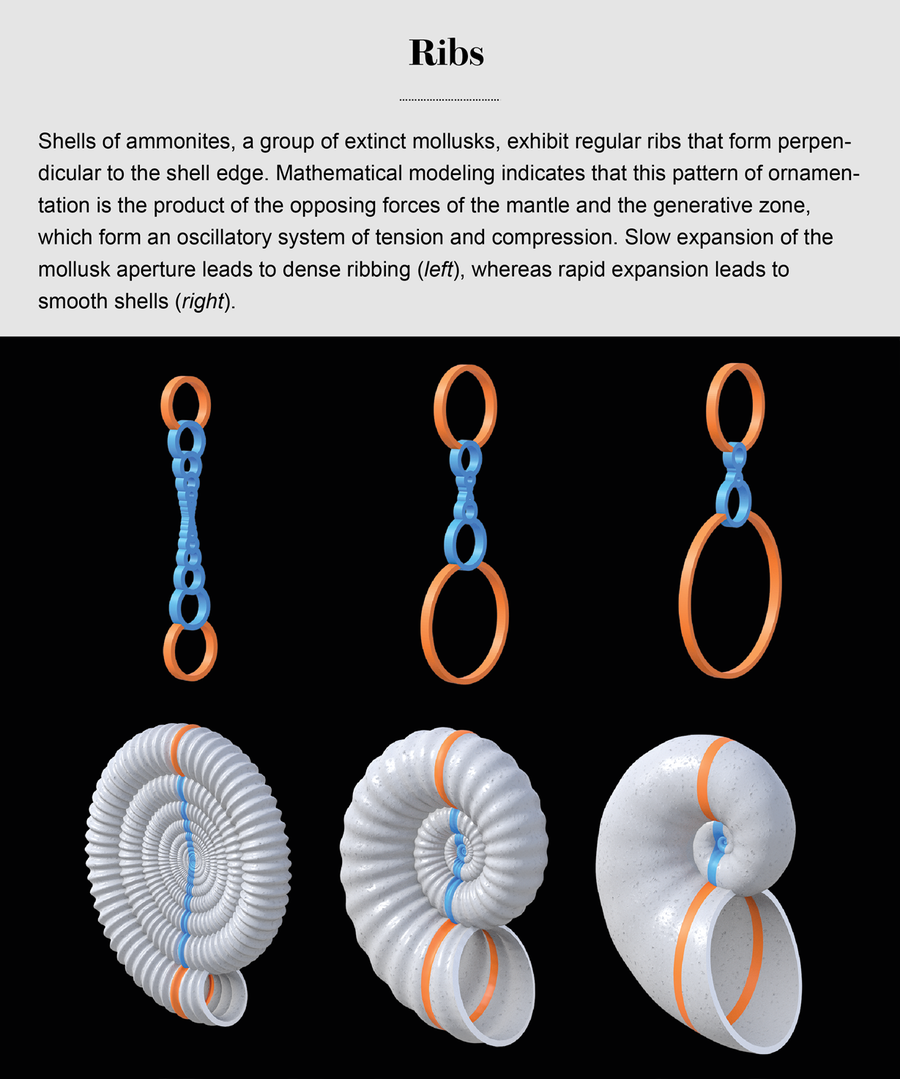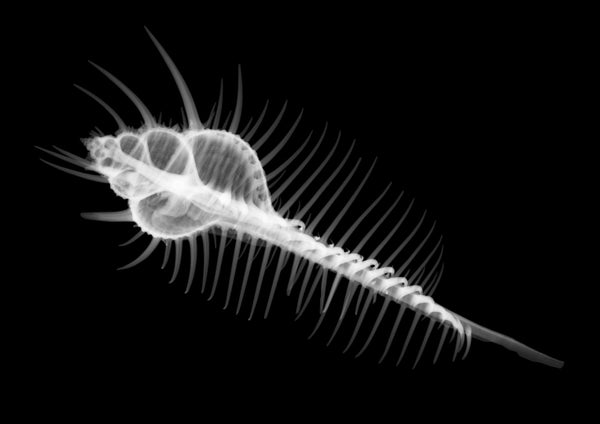Mollusks are fabulous architects. They build houses that protect their soft bodies from predators and the elements—shells of uncommon strength, durability and beauty. Many of these shells have spectacularly complex shapes—logarithmic spirals bedecked with fractal spines or other ornaments, all executed with near-perfect mathematical regularity. Yet mollusks, of course, know nothing of math. How, researchers have wondered, do these humble creatures produce such intricate patterns so precisely?
For more than 100 years scientists have recognized that cells, tissues and organs must respond to the same physical forces that govern other kinds of matter. But for most of the 20th century biologists focused on understanding how the genetic code directs the formation of biological patterns and on figuring out how those patterns function. In recent decades, however, investigators have begun to apply physics-based mathematical modeling to questions about biological form. Our own work along these lines over the past few years has yielded intriguing insights into how shells acquire their ornate structures.
Using the tools of differential geometry, a mathematical discipline that studies curves and surfaces, we have determined that the elaborate shapes of shells arise from a few simple rules that the mollusks follow when constructing their homes. These rules interact with mechanical forces produced during shell growth to generate myriad pattern variations. Our findings help to explain how Byzantine features such as spines have evolved independently in so many lineages of gastropods, which make up the largest mollusk group. These creatures need not undergo the same genetic changes to acquire similar ornaments, because the laws of physics do most of the work.
On supporting science journalism
If you're enjoying this article, consider supporting our award-winning journalism by subscribing. By purchasing a subscription you are helping to ensure the future of impactful stories about the discoveries and ideas shaping our world today.
Rules of Construction
The business of building the shell falls to the mollusk's mantle. This thin, soft organ secretes layer on layer of a substance rich in calcium carbonate at the opening, or aperture, of the shell. It only needs to follow three basic rules to form the characteristic spiral seen in the shells of snails and their relatives, the gastropods. The first rule is expand: by uniformly depositing more material than it did on the previous pass, the mollusk creates a slightly larger opening at each iteration. This process generates a cone from an initial circle. The second rule is rotate: by depositing slightly more material on one side of the aperture, the mollusk achieves a full rotation of that aperture, building a doughnut shape, or torus, from an initial circle. The third rule is twist: the mollusk rotates the points of deposition. Follow just the expand and rotate operations, and you get a planospiral shell like that of the chambered nautilus. Add the twist step, and the result is what mathematicians describe as a nonplanar, helicospiral shell.
For some shell builders, that is the end of the story, as sleek and elegant a home as one could want. For others, some embellishment is in order. To understand how ornaments such as spines form, we must examine the forces produced during shell growth. The shell secretion process revolves around an interesting mechanical system. The mantle is attached to the shell via the so-called generative zone, a region of secreted but not yet calcified material. It is in this interaction between mantle and shell that the potential for pattern formation exists. Any mismatch between mantle and aperture will physically stress the mantle tissue. If the mantle is too small for the opening, it will have to stretch to attach to it. If the mantle is too large, it will have to compress to fit. And if the generative zone becomes deformed because of these stresses, the new material the mantle secretes at that stage will assume the deformed shape and permanently solidify in the shell, further influencing the mantle at the next growth step. Essentially, if the shell does not grow at the exact same rate as the growing mollusk, deformations will arise, generating features we recognize as ornaments.
.png?w=900)
Credit: Bryan Christie Design (illustrations); Ben Brain Getty Images (Nautilus); Nick Veasey Getty Images (Turritella communis)

Credit: Bryan Christie Design (illustrations); Nick Veasey Getty Images (Bolinus brandaris)

Credit: Bryan Christie Design
Spines constitute the most prominent ornamentation, typically protruding at a right angle to the shell aperture and often extending centimeters beyond the shell surface. These projections form at regular periods in which the mantle undergoes a growth spurt. During a growth spurt, the mantle develops so quickly that it has an excess of length and cannot align with the aperture. This mismatch causes the mantle to buckle slightly. The material it secretes assumes the buckled shape. By the next increment, the mantle has grown further and has again exceeded the aperture, which has the effect of amplifying the buckled pattern. We reasoned that this repeated process of growth and mechanical interaction gives rise to a row of spines, the precise pattern of which is determined primarily by the rate of the growth spurt and the stiffness of the mantle.
To test this idea, we developed a mathematical model of a mantle growing on a foundation that evolves at each iteration. As we experimented with typical growth and material properties in the model, a wide variety of spine patterns emerged, similar to the forms that are observed in real shells, confirming our hypothesis.
This Old House
Spines are not the only flourish that mollusks may add to their shells. Another type of pattern is found on the shells of ammonites, a group of extinct mollusks related to today's cephalopods (nautiluses, octopuses and their cousins). Ammonites ruled the seas for 335 million years before disappearing around 65 million years ago. The abundance of their fossilized remains, along with their great diversity of forms and apparently high rate of evolution, has made them one of the most studied groups of fossil invertebrates.
The most striking characteristic of the ammonite shell beyond its planar-logarithmic spiral form is the regular ribbing that runs parallel to the shell edge. This ornamentation probably stems from the same mechanical conflict that produces spines, yet it is a completely different pattern. The forces are the same, but the magnitude and the geometry on which they operate are not.
The aperture of the ammonite is basically circular. If the mantle radius is larger than the current aperture radius, the mantle will be compressed but not enough to generate the degree of elastic instability needed to produce spines. Rather the compressed mantle pushes outward, and the shell radius at the next increment is larger. But this outward motion is opposed by the calcifying generative zone, which acts as a torque spring trying to maintain the current shell orientation.
We surmised that the effect of these two opposing forces is an oscillatory system: the shell radius increases, reducing compression, but overshoots to a state of tension; the “stretched” mantle then pulls inward to decrease its tensile force, again overshooting to a state of compression. A mathematical description of this “morphomechanical oscillator” confirmed our hypothesis, producing regular ribs with a wavelength and amplitude that increased during the growth and development of the mollusk. These mathematical predictions closely resemble the known forms of ammonites.
Mathematical modeling also predicts that the greater the expansion rate of the growing mollusk—the rate at which the diameter of the shell opening increases—the less pronounced its ribs are. These findings help to explain the observation that increased aperture curvature correlates with increased ribbing pattern, an evolutionary trend that has been noted by paleontologists for more than a century.
This relation between expansion rate and ribbing also provides a simple mechanical and geometric explanation for a long-standing puzzle of mollusk evolution: the shells of the chambered nautilus and its relatives—a group known as the nautilids—have remained essentially smooth since at least 200 million years ago, leading some observers to suggest that the group has apparently not evolved in that time. Indeed, today's few surviving nautilid species are often described as “living fossils.” Our biophysical growth model, however, shows that the smoothness of nautilid shells is merely a mechanical consequence of rapid aperture expansion. The nautilids' lineage may have evolved more than their shell morphology suggests, but lacking the distinctive ornamental patterns that paleontologists use to distinguish species, their actual evolution remains largely hidden.
We still have much to learn about how mollusks make their marvelous abodes. A short stroll through any good shell collection reveals a number of patterns scientists have yet to explain. For example, roughly 90 percent of gastropods are “right-handed,” building their shells such that they coil in a clockwise direction. Only 10 percent wind to the left. Scientists have only just begun to probe the mechanisms that lead to this prevalence of right-handedness. The origins of some exquisite ornamentations are likewise unknown, such as the fractallike spine pattern found in a number of species in the muricid family of mollusks. Also, although we know that environmental factors influence shell growth rate, the impact of these variables on shell form is less clear.
With these and other mysteries still surrounding seashells—which are model organisms for exploring broader questions about pattern formation in nature—we have our work cut out for us. But an understanding of the physical forces that govern their development only heightens their allure.

